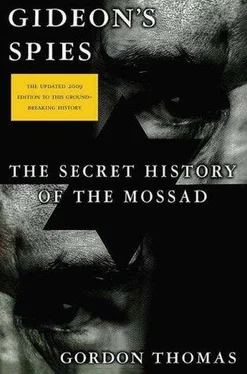Meir Amit recognized his katsas would need support in the field. He created the sayanim, volunteer Jewish helpers. Each sayan was an example of the historical cohesiveness of the world Jewish community. Regardless of allegiance to his or her country, in the final analysis a sayan would recognize a greater loyalty: the mystical one to Israel, and a need to help protect it from its enemies.
Sayanim fulfilled many functions. A car sayan, running a rental agency, provided a katsa with a vehicle without the usual documentation. A letting agency sayan offered accommodation. A bank sayan might unlock funds outside normal hours. A sayan physician would give medical assistance—treating a bullet wound for example—without informing the authorities. Sayanim only received expenses for their services.
Between them they collected technical data and all kinds of “overt” intelligence: a rumor at a cocktail party, an item on the radio, a paragraph in a newspaper, a half-finished story at a dinner party. They provided leads for katsas . Without its sayanim Mossad could not operate.
Again, Meir Amit’s legacy would remain, though vastly expanded. In 1998 there were over four thousand sayanim in Britain, almost four times as many in the United States; while Meir Amit had operated on a tight budget, Mossad, to maintain its worldwide operations, now spent several hundred million dollars a month maintaining its “assets,” paying the expenses of sayanim, running safe houses, providing logistics and covering operational costs. He had left them one other reminder of his time as their chief: a language of their own. Its report writing system was known as Naka; “daylight” was the highest form of alert; a kidon was a member of Mossad’s assassination team; a neviot was a specialist in surveillance; yaholomin was the unit that handled communications to katsas ; safanim was the one that targeted the PLO; a balder was a courier; a slick was a secure place for documents; teuds were forgeries.
On that March morning in 1997, as he drove to keep a rendezvous with the past, Meir Amit knew so much had changed in Mossad. Pressured by political demands, most notably from Prime Minister Benyamin Netanyahu, Mossad had become dangerously isolated from the foreign intelligence services Meir Amit had so carefully courted. It was one thing to live by the credo “Israel first, last, and always. Always.” It was quite another, as he put it, to be caught “going through the pockets of your friends.” The key word was “caught,” he added with another bleak smile.
An example had been Mossad’s increased penetration of the United States through economic, scientific, and technological espionage. A special unit, code-named Al, Hebrew for “above,” prowled through California’s Silicon Valley and Boston’s Route 128 for high-tech secrets. In a report to the Senate Intelligence Committee, the CIA had identified Israel as one of six foreign countries with “a government-directed, orchestrated, clandestine effort to collect U.S. economic secrets.”
The president of Germany’s internal intelligence organization, the Bundesamt Fur Verfassungschatz (BFD), had recently warned his department heads that Mossad remained a prime threat to steal the republic’s latest computer secrets. A similar caution was issued by France’s Direction Générale de la Sécurité Exterieure (DGSE) after a Mossad agent had been spotted near the Satellite Imagery Interpretative Center at Creil. Israel had long tried to increase its capability in space to match its nuclear capability on earth. Britain’s counterespionage service, MI5, included in its briefing to newly elected prime minister Tony Blair details of Mossad’s efforts to obtain sensitive scientific and defense data in the United Kingdom.
Meir Amit did not object, as such, to these adventures, only that they often appeared to have been carried out with a lack of planning and disregard for long-term consequences.
The same applied to how LAP’s psychologists conducted their campaigns. In his days the department had built up a global network of media contacts and used them with great skill. A terrorist incident in Europe would produce a call to a news organization contact with “background” that was of sufficient interest to be worked into the story, giving it the spin LAP wanted. The unit also created information for press attachés at Israeli embassies to pass on to a journalist over a drink or dinner, when a “secret” could be quietly shared and a reputation discreetly tarnished.
While the essence of that black propaganda still remained, there was a crucial difference: the choice of a target or victim. It appeared to Meir Amit that the decision was too often predicated on political requirements : a need to divert attention from some self-serving diplomatic maneuver Israel planned to make in the Middle East, or to regain its fluctuating popularity, especially in the United States.
When Trans World Airlines Flight 800 crashed off the southeastern coast of Long Island on July 17, 1996, killing all 230 people on board, LAP began a campaign to suggest the tragedy was masterminded by Iran or Iraq, both Israel’s bêtes noires. Thousands of media stories quickly perpetuated the fiction. Almost a year later, after expending some five hundred thousand dollars and ten thousand work hours, the FBI’s chief investigator, James K. Kallstrom, ruled out a terrorist bomb or any evidence of a forensic crime. Privately he told colleagues, “If there was a way to nail those bastards in Tel Aviv for time wasting, I sure would like to see it happen. We had to check every item they slipped into the media.”
LAP struck again after the bombing of the Atlanta Olympic Games. The fiction was spread that the bomb had “all the signs” of being manufactured by somebody who had learned his skills from the bomb makers of Lebanon’s Bekáa Valley. The story took off—and LAP brought the specter of terrorism home to an understandably fearful American public. The only suspect was a hapless security guard at the Games—a man who manifestly had no connection with international terrorism—and when he was cleared, the story died.
Again, Meir Amit understood the importance of reminding the world about terrorism. But the warning “needed to be copper-fastened, something I always insisted upon.” The admission was followed by a shrug, as if some inner fire blanket had doused his spark of irritation. Long ago he had learned to hide his feelings and to be vague about details ; for years his strength had been in concealment.
In his mind the downward spiral of Mossad had begun when Prime Minister Yitzhak Rabin was assassinated at a peace rally in Tel Aviv in November 1995. Shortly before Rabin was gunned down by a Jewish extremist—a further sign of the deepening malaise Meir Amit saw in Israeli society—Mossad’s then director general, Shabtai Shavit, had warned Rabin’s staff that there might be an attempt on his life. According to one staffer the possibility was ignored as being too vague “to constitute a definite threat.”
Under Meir Amit’s command Mossad still had no mandate to operate within Israel, any more than the CIA could do so within the United States. Yet, despite his criticisms, Meir Amit liked to say that Mossad had shared the destiny of Israel. Under his tenure the impact of what it did had often reverberated around the world. Much of that he put down to loyalty, a quality that now seemed to have become passé. People still did their work—as dangerous and dirty as it had always been—but they wondered if they would be held accountable not only to some superior, but to some political figure in the background. That interference could account for the paranoia that regularly surfaced and challenged the concept that Israel is a true democracy.
Читать дальше












